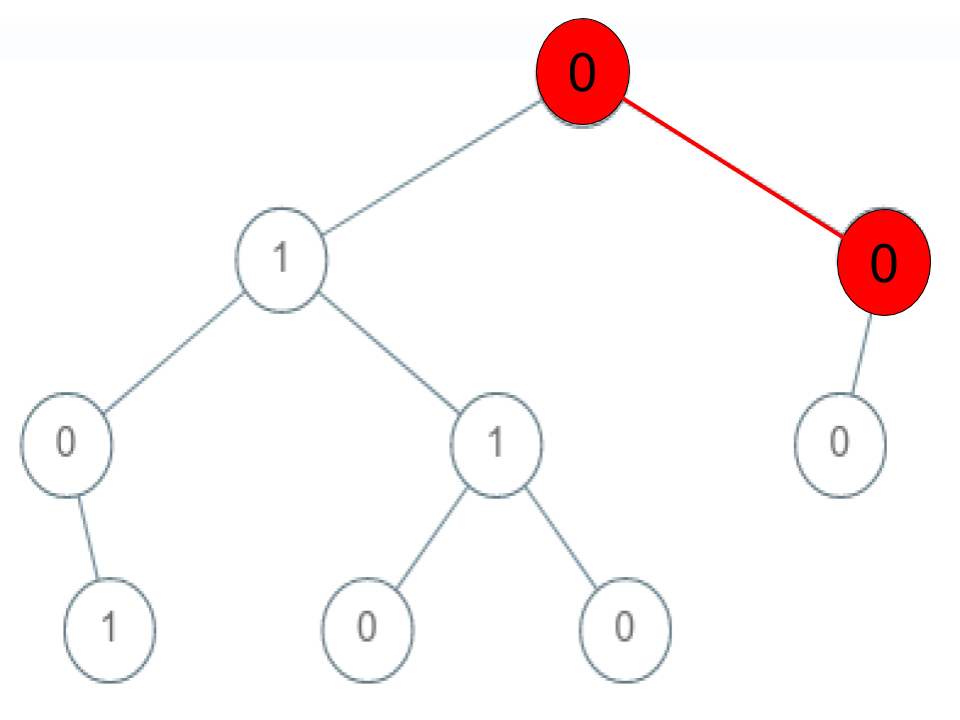1430.Check If a String Is a Valid Sequence from Root to Leaves Path in a Binary Tree¶
Tags: Tree Medium
Links: https://leetcode.com/explore/challenge/card/30-day-leetcoding-challenge/532/week-5/3315/
Given a binary tree where each path going from the root to any leaf form a valid sequence, check if a given string is a valid sequence in such binary tree.
We get the given string from the concatenation of an array of integers arr and the concatenation of all values of the nodes along a path results in a sequence in the given binary tree.
Example 1:

Input: root = [0,1,0,0,1,0,null,null,1,0,0], arr = [0,1,0,1]
Output: true
Explanation:
The path 0 -> 1 -> 0 -> 1 is a valid sequence (green color in the figure).
Other valid sequences are:
0 -> 1 -> 1 -> 0
0 -> 0 -> 0
Example 2:

Input: root = [0,1,0,0,1,0,null,null,1,0,0], arr = [0,0,1]
Output: false
Explanation: The path 0 -> 0 -> 1 does not exist, therefore it is not even a sequence.
Example 3:

Input: root = [0,1,0,0,1,0,null,null,1,0,0], arr = [0,1,1]
Output: false
Explanation: The path 0 -> 1 -> 1 is a sequence, but it is not a valid sequence.
Constraints:
1 <= arr.length <= 50000 <= arr[i] <= 9- Each node's value is between [0 - 9].
/**
* Definition for a binary tree node.
* struct TreeNode {
* int val;
* TreeNode *left;
* TreeNode *right;
* TreeNode() : val(0), left(nullptr), right(nullptr) {}
* TreeNode(int x) : val(x), left(nullptr), right(nullptr) {}
* TreeNode(int x, TreeNode *left, TreeNode *right) : val(x), left(left), right(right) {}
* };
*/
class Solution {
public:
bool isValidSequence(TreeNode* root, vector<int>& arr) {
std::ios_base::sync_with_stdio(false);
cin.tie(NULL);
cout.tie(NULL);
int n = arr.size();
return isValid(root, 0, n - 1, arr);
}
bool isValid(TreeNode *root, int start, int end, vector<int> & arr)
{
if (start == end && root && !root -> left && !root -> right)
return root -> val == arr[start];
if ((!root && start <= end) || (root && start > end)) return false;
if (root -> val != arr[start]) return false;
bool left = start < end ? isValid(root -> left, start + 1, end, arr) : false;
bool right = start < end ? isValid(root -> right, start + 1, end, arr) : false;
return left || right;
}
};
数据范围表明序列不为空,并且始终保证start <= end,一种很直接的思路就是检验当前点是否等于数组里对应的元素,于是我们用start来记录检验到数组的哪个位置,end是数组的边界。然后递归的检验树的左右节点。
既然涉及到递归,首先应该考虑递归的终止条件,终止的情况可能有:
- 树遍历到了叶节点(描述叶节点就是检验左右子树是否为空),数组也遍历到了最后一个元素,那么只需检验叶节点的值和数组元素值是否相等
- 树还没有到叶节点,但是数组已经到了末尾,为
false - 树到了叶节点,但是数组还没有到末尾,为
false
考虑递归中可能存在的问题,因为终止情况已经检验了树节点为空的情况,那么此时树的节点不为空,只需要检验元素是否对应相等即可。最后递归遍历左右子树,结果取或即可。